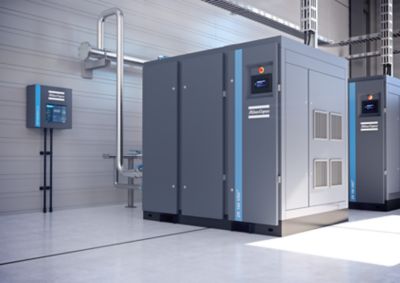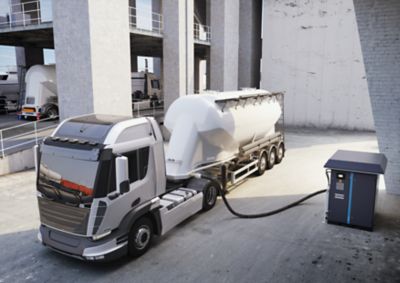Îmbunătățiți calitatea aerului comprimat cu un uscător cu adsorbție
Știați că tot aerul atmosferic conține o anumită cantitate de vapori de apă? Când aerul este comprimat, concentrația sa de apă crește. Pentru a evita problemele viitoare cu configurarea compresorului de aer, este important să tratați acest aer umed. În acest articol, discutăm despre modul de funcționare a unui uscător cu adsorbție și a unui uscător cu adsorbție/desicant.
Ce este uscarea prin adsorbție?
Uscarea prin absorbție este un proces chimic în care vaporii de apă devin legați de materialul absorbant. Materialul de absorbție poate fi fie solid, fie lichid. Clorura de sodiu și acidul sulfuric sunt utilizate frecvent, ceea ce înseamnă că posibilitatea coroziunii merită luată în considerare. Această metodă este neobișnuită și implică un consum ridicat de materiale absorbante. Punctul de rouă scade limitat.
Ce este un uscător cu adsorbție?
Principiul general de funcționare al uscătoarelor de aer cu adsorbție este simplu. Aerul umed curge peste materialul higroscopic (materialele tipice utilizate sunt gelul de siliciu, sitele moleculare și alumina activată) și devine uscat. Când vaporii de apă se transformă din aer comprimat umed în material higroscopic sau „desicant”, desicantul devine treptat saturat cu apă adsorbită.
Prin urmare, este important să regenerați desicantul în mod regulat pentru a-și recâștiga capacitatea de uscare. Uscătoarele de aer cu adsorbție sunt construite de obicei cu două vase de uscare în acest scop. Primul vas va usca aerul comprimat care intră, în timp ce al doilea se regenerează (similar modului de funcționare al unui generator de azot). Fiecare vas ("turn") comută sarcinile atunci când celălalt turn este complet regenerat.
Punctul tipic de rouă sub presiune (PDP) pe care îl ating aceste uscătoare este de -40 °C, ceea ce le face adecvate pentru furnizarea de aer foarte uscat. Există 4 moduri diferite de regenerare a materialului adsorbant, iar metoda utilizată determină tipul de uscător cu adsorbție. Tipurile mai eficiente din punct de vedere energetic sunt de obicei mai complexe și, prin urmare, mai scumpe de achiziționat.
Regenerarea materialului adsorbant
- Uscătoare cu adsorbție regenerată cu purjare ("uscătoare de tip fără căldură"). Aceste uscătoare sunt cele mai potrivite pentru debite de aer mai mici. Procesul de regenerare se realizează cu ajutorul aerului comprimat expandat ("evacuat") și necesită cca. 15-20% din capacitatea nominală a uscătorului la o presiune de lucru de 7 bar(e).
- Uscătoare regenerate cu purjare încălzită. Aceste uscătoare încălzesc aerul de purjare expandat cu un încălzitor electric de aer, limitând debitul de purjare necesar la aproximativ 8%. Acest tip consumă 25% mai puțină energie decât uscătoarele cu încălzire redusă.
- Uscătoare regenerate cu suflantă. Aerul ambiant este suflat peste un încălzitor electric și adus în contact cu materialul adsorbant umed pentru a-l regenera. Cu acest tip de uscător, nu se utilizează aer comprimat pentru regenerarea materialului adsorbant. Prin urmare, consumul de energie este cu 40% mai mic decât la uscătoarele cu căldură redusă.
- Uscătoare regenerate cu căldura de compresie (uscătoare „HOC”). În uscătoarele HOC, materialul adsorbant se regenerează utilizând căldura disponibilă a compresorului. În loc să evacueze căldura aerului comprimat într-un răcitor final, aerul fierbinte este utilizat pentru regenerarea materialului adsorbant. Acest tip de uscător poate furniza un PDP tipic de -20 °C fără a adăuga consum de energie. Un PDP mai scăzut este posibil și prin adăugarea de încălzitoare suplimentare.
Uscătoare cu căldură de compresie
Înainte de uscarea prin adsorbție trebuie asigurată întotdeauna separarea și purjarea apei de condens. Dacă aerul comprimat este produs cu compresoare lubrifiatecu ulei, trebuie montat și un filtru separator de uleiîn amonte de echipamentul de uscare.
În majoritatea cazurilor, este necesară utilizarea unui filtru de particule după uscarea prin adsorbție. Uscătoarele cu căldură de compresie (HOC) pot fi utilizate numai cu compresoare fără ulei, deoarece produc căldură la temperaturi suficient de ridicate pentru regenerarea uscătorului. Un tip special de uscător HOC este uscătorul cu adsorbție cu tambur rotativ.
Acest tip de uscător are un tambur rotativ umplut cu material adsorbant. Astfel, un sector de 1/4 este regenerat cu un flux parțial de aer comprimat cald (la 130-200 ̊C). Aerul regenerat este apoi răcit, iar condensul este golit înainte ca aerul să fie returnat printr-un dispozitiv ejector în fluxul principal de aer comprimat.
Restul suprafeței tamburului (trei sferturi) este utilizat pentru a usca aerul comprimat provenit de la răcitorul final al compresorului. Un uscător HOC evită pierderea de aer comprimat, iar necesarul de putere este limitat la cel necesar pentru rotirea tamburului. De exemplu, un uscător cu o capacitate de 1000 l/s consumă numai 120 W de putere electrică. În plus, nu se pierde aer comprimat și nu sunt necesare filtre de ulei sau de particule.
Această carte electronică despre uscătoarele de aer comprimat conţine toate detaliile despre umiditate şi rolul important al uscătoarelor în tratarea aerului.
Aveţi întrebări sau doriţi să luaţi legătura cu un expert? Faceţi clic pe butonul de mai jos şi vă vom contacta în scurt timp.
Articole asociate
27 aprilie, 2023
Uscarea aerului refulat este foarte importantă dacă doriți să evitați problemele din sistemul de aer comprimat. Aflați mai multe despre motivul pentru care este necesară uscarea și cum se face.
11 noiembrie, 2022
Alegerea uscătorului potrivit pentru un sistem de aer comprimat este la fel de importantă ca alegerea compresorului în sine. Vă vom arăta la ce să vă uitați atunci când cumpărați un uscător.
18 octombrie, 2022
Trebuie luate decizii importante atunci când instalați un sistem de aer comprimat pentru ca acesta să se potrivească diferitelor nevoi și să ofere calitatea corectă a aerului.

